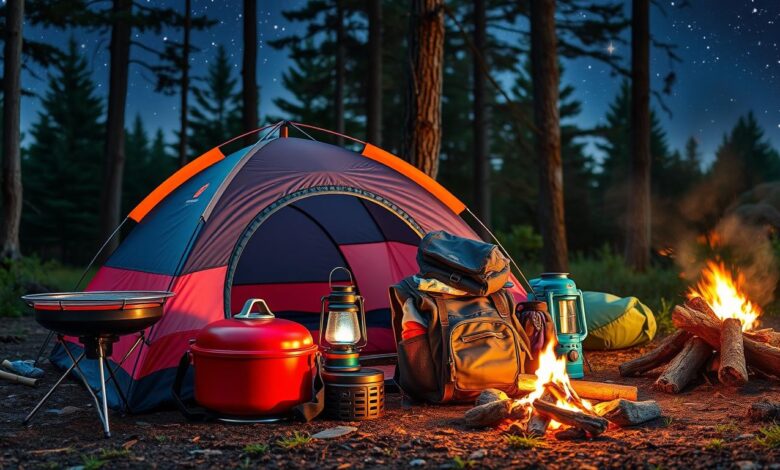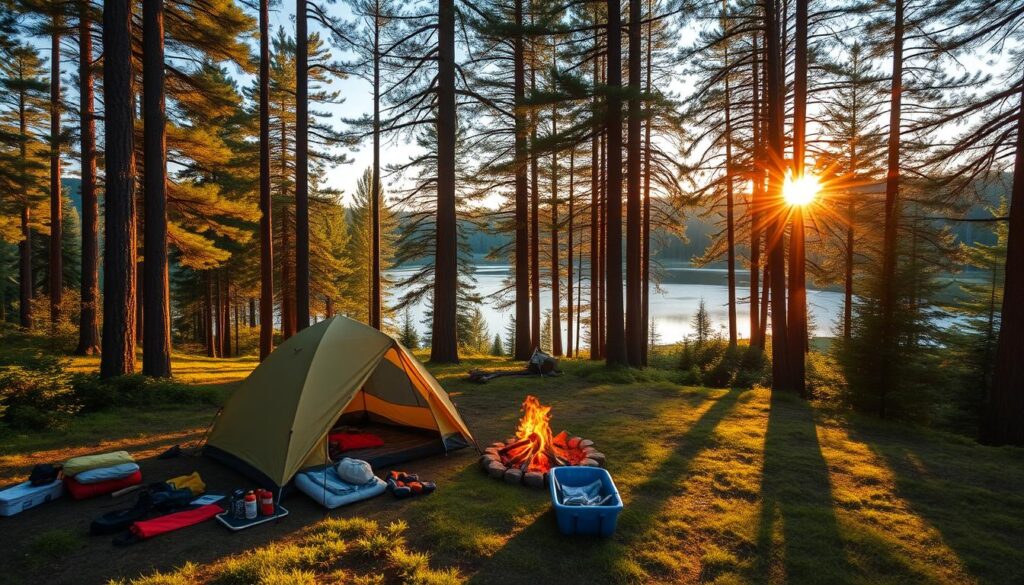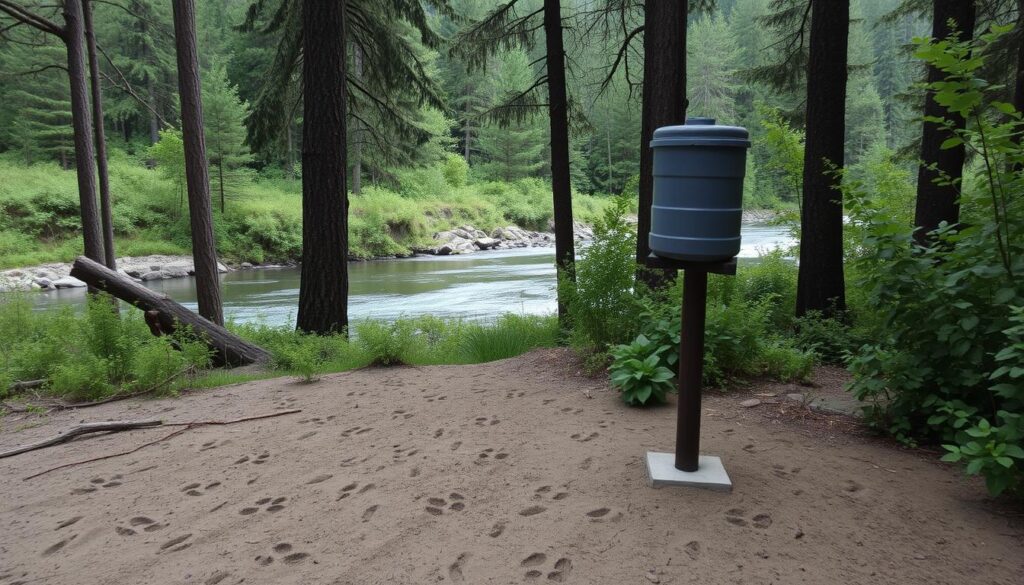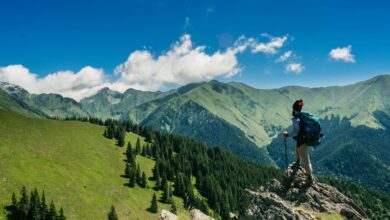Camping Essentials: Must-Have Gear and Tips for an Unforgettable Trip

Camping is a thrilling outdoor adventure that lets you connect with nature. It’s a great way to make lasting memories. To have a successful trip, you need the right gear and knowledge.
With the right mindset and preparation, your camping trip can be unforgettable. Whether you’re experienced or new to camping, having the right gear and knowledge is key. We’ll guide you through everything you need for a safe and fun camping trip.
Introduction to Camping
Camping is a wonderful way to enjoy nature’s beauty. With the right gear and knowledge, you can make your outdoor adventures unforgettable. In this article, we’ll explore camping gear, safety, and environmental considerations. We aim to help you have a great camping trip.
Key Takeaways
- Having the right camping gear is essential for a successful and enjoyable trip
- Understanding environmental considerations is crucial for responsible camping
- Preparation and knowledge are key to a safe and enjoyable camping experience
- Camping offers a unique opportunity to connect with nature and create lifelong memories
- Choosing the right equipment is vital for a comfortable and enjoyable camping experience
- Camping is an ideal activity for those who love outdoor adventures and want to escape the hustle and bustle of daily life
Understanding Basic Camping Equipment Needs
Having the right gear is crucial for a safe and fun camping trip. Camping equipment needs change based on the season, type of camping, and the environment. For example, wilderness survival needs special items like water purification tablets and a first aid kit, unlike a casual hiking trip.
It’s important to know your camping spot and choose the right gear. Think about the weather, terrain, and potential dangers like wildlife and steep slopes. This way, you can pack the right camping equipment and be ready for anything.
- Seasonal needs, like warm clothes for winter or bug spray for summer
- The type of camping, like backpacking or car camping, which needs different gear
- The environment, like rough terrain or extreme weather, which calls for special equipment
By understanding your camping equipment needs and preparing well, you can have a safe and fun hiking and camping adventure. You’ll also be ready for any wilderness survival challenges that come your way.
| Season | Camping Equipment Needs |
|---|---|
| Summer | Insect repellent, sunscreen, lightweight clothing |
| Winter | Warm clothing, insulated sleeping bag, snow shovel |
Essential Shelter and Sleeping Gear
Having the right shelter and sleeping gear is key for a good camping trip. This is even more important for backpacking, where every ounce matters. A good tent, sleeping bag, and sleeping pad can greatly improve your camping experience.
When picking your gear, think about the weather, your comfort, and how easy it is to carry. For rainy areas, choose a waterproof tent with a strong frame. If you get cold at night, pick a sleeping bag that’s warm enough.
Here are some camping tips for setting up your shelter and sleeping gear:
- Choose a flat and dry spot for your tent
- Use stakes and ropes to secure your tent
- Invest in a good sleeping pad for extra comfort
By following these tips and choosing the right gear, you’ll have a great camping trip. Whether you’re experienced or new to backpacking, the right gear makes a big difference.
Camping Kitchen Essentials and Food Planning
Having a well-planned camping kitchen is key for a great camping trip. It’s not just about cooking outdoors but also keeping food safe and healthy. A camping kitchen has portable cooking gear, food storage, and water filters.
Portable cooking gear like stoves and grills are essential. They make cooking in the wild easy. Also, using airtight containers is crucial to keep food fresh and safe from animals.
Portable Cooking Equipment
Camping stoves from Coleman and Jetboil are popular choices. They provide efficient cooking solutions. Remember to choose the right fuel and always use cooking gear safely.
Food Storage Solutions
Keeping food safe is vital for a good camping trip. Use airtight containers and hang food bags to keep animals away. Store food and trash securely to keep your campsite clean and healthy.
Investing in the right camping kitchen gear makes outdoor cooking safe and enjoyable. Always follow safety tips for cooking and storing food to have a great camping trip.
Navigation and Safety Equipment
Camping requires the right tools for navigation and safety. You’ll need maps, compasses, and emergency devices. Navigation skills are key to finding your way. Emergency communication devices can save lives in emergencies.
Don’t forget the safety equipment like a first aid kit. A good kit has bandages, antiseptic wipes, and pain relievers. Include personal meds and a first aid guide too.
Maps and Compass Basics
Maps and compasses are vital for navigating. A map shows your location and route. A compass keeps you on track. Consider a GPS or GPS app on your phone as a backup.
Emergency Communication Devices
Having a way to communicate in emergencies is crucial. Use a cell phone, two-way radio, or satellite phone. A whistle or signaling device can also help if you’re lost or hurt.
First Aid Essentials
A first aid kit should have basic items like bandages and antiseptic wipes. Include pain relievers and any personal meds. A first aid guide is also important.
- Bandages and band-aids
- Antiseptic wipes and spray
- Pain relievers and antihistamines
- Blister and burn care
With the right tools, including maps, compasses, emergency devices, and first aid kits, camping can be safe and fun.
Clothing and Personal Comfort Items
Having the right camping clothing is key for a great camping trip. It’s important to wear layers. This lets you adjust to the weather and how active you are. Choose clothes that breathe and wick away moisture to stay dry and comfy.
For cold weather, a warm hat, gloves, and scarf are must-haves. Also, remember to pack toothbrush, toothpaste, and biodegradable soap. These small things can make a big difference in your comfort and fun.
Other important outdoor gear includes a sleeping bag, sleeping pad, and a portable chair. They help you sleep well and relax during the day. Here are some tips for picking the best camping clothing and outdoor gear:
- Choose items that are durable and waterproof
- Consider the season and activity level when selecting clothing
- Don’t forget to pack essential hygiene items
By focusing on personal comfort and getting the right camping clothing and outdoor gear, you’ll have a comfy and fun camping trip.
| Item | Description |
|---|---|
| Camping Clothing | Breathable, moisture-wicking fabrics |
| Personal Comfort Items | Warm hat, gloves, scarf, hygiene items |
| Outdoor Gear | Sleeping bag, sleeping pad, portable camping chair |
Setting Up Your Camping Site Like a Pro
Setting up a camping site requires careful planning for a comfortable trip. The right spot is key, offering access to water, level ground, and protection from the weather.
A good camp organization plan helps use space wisely and keeps the environment clean. This includes a sturdy, waterproof tent setup and areas for cooking, sleeping, and storing gear. These steps help create a functional and cozy campsite.
Choosing the Perfect Spot
When picking a camping spot, think about the terrain, climate, and how easy it is to get to. A spot with level ground and near water is best. It should also protect you from wind, sun, and rain.
Tent Setup Techniques
A well-set tent setup is vital for a dry and comfy camping stay. Pick a tent that fits your group and the weather. Make sure it’s staked down well and has a waterproof rain fly.

Camp Organization Tips
To keep your camping site tidy, set up areas for cooking, sleeping, and storing things. Always have a trash bag ready and dispose of waste correctly. These camp organization tips make your camping trip more enjoyable.
By considering these points and using these tips, you can create a camping site that’s both practical and cozy. This lets you enjoy the outdoors without hassle. Always remember to follow camp organization and tent setup principles for a great camping experience.
Essential Camping Tools and Repairs
When you head into the wilderness, having the right camping tools is key. A multi-tool, duct tape, and a repair kit are must-haves. These tools help fix gear like tents, sleeping bags, and backpacks. They’re crucial in emergencies.
It’s also vital to have the right outdoor gear for different situations. A good repair kit should have patches, glue, and rope. Being prepared with the right camping tools and knowing how to fix things helps the environment and makes your trip successful.
Some essential items for your outdoor gear are:
- Waterproof matches
- First aid kit
- Extra batteries
- Map and compass
Investing in quality camping tools and learning basic repairs makes camping better. You’ll enjoy a more self-sufficient and rewarding experience in nature with the right outdoor gear.
Wildlife Safety and Food Storage Protocols
When you go outdoors, keeping wildlife safety and food storage top of mind is key. This is especially true in bear country, where bears are attracted to food and trash. This can lead to dangerous situations.
To avoid attracting wildlife, it’s important to store food and trash right. Use airtight containers and keep your campsite clean. Also, dispose of waste in the right places. In bear country, use bear-resistant containers or hang food and trash bags high up in a tree.

- Keep a clean campsite, and avoid leaving food or trash out in the open
- Use food storage containers that are airtight and bear-resistant
- Be aware of your surroundings, and watch for signs of wildlife, such as tracks or scat
By following these tips, you can lower the chance of a wildlife encounter. This way, you can have a safe and fun camping trip in bear country.
| Wildlife Safety Tips | Food Storage Methods |
|---|---|
| Keep a clean campsite | Use airtight containers |
| Be aware of your surroundings | Hang food and trash bags from a tree |
Environmental Impact and Leave No Trace Principles
When we go into the great outdoors, we must think about how our actions affect the environment. As campers, we need to make sure we don’t harm nature. The Leave No Trace principles help us do just that, keeping the wilderness as we found it.
Practicing sustainable camping is key to reducing our impact. We should pick campsites that can handle visitors, throw away trash right, and use resources wisely. Using eco-friendly gear, saving water, and respecting wildlife are all important parts of sustainable camping.
- Using reusable water bottles and coffee cups
- Packing out all trash and recyclables
- Building campfires in designated areas and fully extinguishing them before leaving
By following these sustainable camping practices and Leave No Trace principles, we can enjoy nature while protecting it. Every small action we take helps. Together, we can make a big difference in keeping the wilderness beautiful for the future.
Weather Preparedness for Camping Adventures
When you go camping, weather preparedness is key for a safe and fun trip. Knowing the weather and having the right outdoor gear is crucial. Always check the forecast and be ready for sudden weather changes.
To stay safe while camping, you need the right gear and clothes for any weather. This means waterproof jackets, warm layers, and strong tents for windy or rainy days. A camper should also have a first aid kit, a flashlight, and a battery-powered radio for weather updates.
Some must-haves for your weather preparedness kit are:
- Waterproof matches or a lighter
- A warm blanket or emergency blanket
- A portable charger for your phone or other devices
- A small toolkit with a knife, scissors, and pliers
Being prepared and having the right outdoor gear helps you enjoy camping more. Always check the weather forecast before you go and stay updated on any weather changes.
Conclusion: Making Your Camping Experience Memorable and Safe
When you go camping next, remember that being prepared and safe is key. This guide has all you need to know for a great time outdoors. You’ll be ready to explore the wilderness with confidence and make memories that last.
It doesn’t matter if you’re a seasoned camper or new to it. Always put safety first for yourself and the environment. Be kind to wildlife, follow the leave-no-trace rule, and watch out for bears. With the right gear and knowledge, your camping experience will be exciting and responsible.
So, get your gear ready, put on your hiking boots, and head out into nature. Enjoy the beauty of the outdoors, challenge yourself, and take a break from everyday life. Remember, a safe and outdoor adventures are waiting for you. Just be brave enough to explore and see the world’s wonders.
FAQ
What are the essential pieces of camping equipment I need for a successful trip?
A sturdy tent and a warm sleeping bag are key. You’ll also need a comfortable sleeping pad. A portable stove and cookware, along with a water filtration system, are crucial. Don’t forget a first aid kit and navigation tools like a map and compass.
How do I choose the right campsite?
Look for level ground and water sources nearby. The site should protect you from the elements and have minimal environmental impact. Avoid areas close to wildlife trails or steep terrain.
What should I pack for food and cooking while camping?
Pack non-perishable, high-calorie foods that are easy to prepare. Get a portable camping stove and the right cookware. Bring a reliable water filtration system and food storage containers to keep wildlife away.
How can I ensure my safety in the wilderness?
Pack a first aid kit, emergency communication devices, and survival tools. Learn basic navigation and wilderness survival skills. Be ready for unexpected weather changes or wildlife encounters.
What should I consider when packing my camping clothes and gear?
Pack clothes that can be layered and moisture-wicking. Choose items suitable for the season and climate. Bring extra socks, gloves, and rain gear. Don’t forget personal comfort items like camp chairs and pillows.
How can I minimize my environmental impact while camping?
Follow the Leave No Trace principles. Pack out all trash, use established campsites, and respect wildlife habitats. Use eco-friendly gear, conserve water, and be mindful of your campfire impact.
What are the key considerations for setting up a comfortable and safe campsite?
Choose a level, well-drained area for your campsite. Secure your tent properly. Organize your camp to maximize space and efficiency. Be mindful of proper food storage to avoid attracting wildlife.
How can I prepare for and respond to potential weather challenges while camping?
Stay informed about weather forecasts. Pack the right gear for the expected conditions. Be prepared to adjust your plans if the weather changes. Know how to set up your tent and campsite for different weather conditions.


